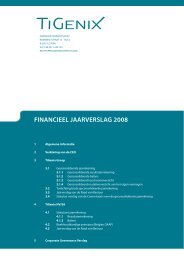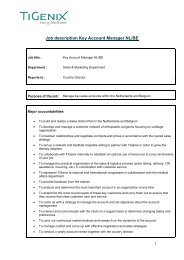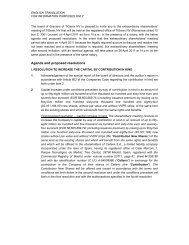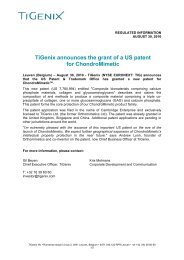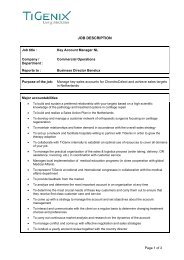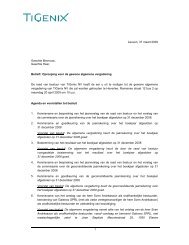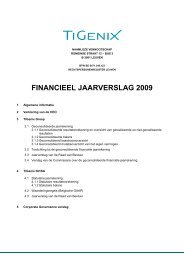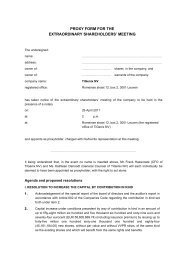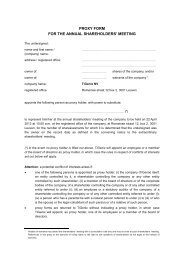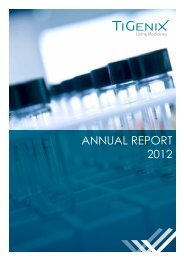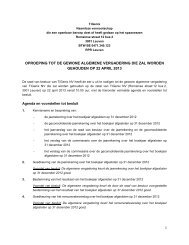ANNUAL FINANCIAL REPORT 2010 2010 - TiGenix
ANNUAL FINANCIAL REPORT 2010 2010 - TiGenix
ANNUAL FINANCIAL REPORT 2010 2010 - TiGenix
- No tags were found...
You also want an ePaper? Increase the reach of your titles
YUMPU automatically turns print PDFs into web optimized ePapers that Google loves.
egulatory environment and to contribute, as an experiencedindustry player in the field, to the shaping of future guidancedocuments.For classic pharmaceutical and biological products, the preclinicaland clinical development paths are broadly similar inEurope and in the U.S. Initially, pre-clinical studies (both in vitroand in vivo) are conducted to evaluate the mode of action(proof of concept/principle) and to establish adequate proofof safety. Upon successful completion of pre-clinical studies,regulatory authorities may grant approval for clinical trials,which are typically conducted in three sequential phases thatmay overlap. In Phase I clinical trials, which consists of theinitial introduction of the pharmaceutical into healthy humanvolunteers, the emphasis is on testing for safety and adverseeffects, dosage tolerance, metabolism, distribution, excretionand clinical pharmacology. Phase II clinical trials consist ofstudies in a limited patient population to determine the initialefficacy of the pharmaceutical for specific targeted indications,to determine dosage tolerance and optimal dosage and toidentify possible adverse side effects and safety risks. Once acompound shows evidence of effectiveness and is found tohave an acceptable safety profile in Phase II clinical trials, PhaseIII clinical trials are undertaken to more fully evaluate clinicaloutcomes. In these Phase III trials, which are often referredto as registration, pivotal or confirmatory studies, the finalproduct candidate is tested for its efficacy in a large trial settingin the relevant patient group(s). The product is usually testedin a blinded controlled randomised trial comparing the newproduct to an approved form of therapy. The goal of thesestudies is to obtain strict statistical evidence of the efficacy andsafety of the new product compared to the control.Given the specific nature of cell-based products, the clinicaldevelopment paths are less standardized than for classicpharmaceutical or biological products. Phase I studies areoften not relevant, in particular for autologous cell-basedproducts, since cells often need to be directly implanted intoa tissue defect only present in patients. As cellular therapyPhase III studies are very complex to organize, often limitednumbers of patients can be enrolled, and follow up times canbe very long, so that the design and execution of these largeconfirmatory trials might not always be possible to the classicalextent. Upfront discussions and agreement with the regulatoryauthorities is an important criterion to success. It is alsoexpected that new regulatory guidance will become availablein the near future, more clearly describing the regulatoryexpectations.Upon successful completion of the above-referred clinicaltrials, a company can submit an application for marketingauthorisation to the relevant regulatory authority. Afterreview of the application, the regulatory authority may grantmarketing authorisation, deny the application or requestadditional information, including further clinical testing ofthe drug candidate. When granting marketing authorisation,a Regulatory Authority may impose upon the sponsor anobligation to conduct additional clinical testing, referredto as Phase IV clinical trials or post-approval commitments,to monitor the drug after commercialisation. Additionally,marketing authorisation may be subjected to limitations on theindicated uses for the drug.Europe – EMA approval processAlthough different terminology is sometimes used, the generalapproval process for medicinal products by the EMA in Europeis quite similar to the process in the U.S. described above.Similar to the US, prior regulatory approval is required in EUMember States for conducting clinical trials on human healthyvolunteers. Currently, in each EU Member State, relevant datais submitted in summarised format to the relevant regulatoryauthority in the Member State in respect of applications forthe conduct of clinical studies (Phases I to IV). The regulatoryauthorities in the European Union typically have betweenone (1) and three (3) months from the date of receipt of theapplication to raise any objections to the proposed clinicaltrial and they often have the right to extend this review periodat their discretion. The authorities may require additionaldata before allowing the studies to commence and coulddemand that the studies be discontinued at any time if thereare significant safety issues. In addition to obtaining regulatoryapproval, clinical trials must receive Ethics Committee approval.The exact composition and responsibilities of the EthicsCommittees differ from one EU Member State to another.In each EU Member State, one or more independent EthicsCommittees (depending on whether the study is a monocentreor multicentre clinical trial) will review the ethics of conductingthe proposed research.Upon successful completion of final Phase III trials, thesponsor can submit a Marketing Authorisation Application(MAA) for the drug candidate. In Europe, three routes exist toobtain marketing approval for the product: national productapplication, mutual recognition or decentralized procedureincluding several EU countries, and the Central Procedure atthe EMA granting a licence for the whole European Unionand Norway, Iceland, and Liechtenstein. ATMP products,232 • <strong>TiGenix</strong> • Rights Offering



